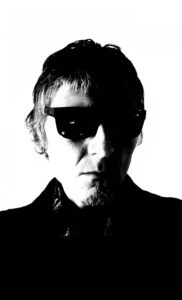 Could you share more about your journey as an autodidactic artist? What inspired you to start creating art, particularly collages?
Could you share more about your journey as an autodidactic artist? What inspired you to start creating art, particularly collages?
Well I always dreamed of being a Psychedelic musician in the vain of Syd Barrett or Arthur Lee and studied music in High school, but when this never eventuated I had to find my artist medium through the process of elimination and experimentation which took quite a while. Being a loner and an outsider my friends were my books and records and they were my initial inspirations, generally cool stuff from the 60s and 70s. They were my teachers and mentors as well. The thing about being Autodidactic (self taught) is that there were no restrictions, just complete freedom to create, which may scare a lot of Artists but I didn’t have to unlearn what institutionalised artists had drilled into them. I came to Collage after many journeys into painting didn’t work for me, it was impossible to project what I had in my mind to physical form with painting, as my thoughts were too complex, detailed, over the top. Besides I wasn’t good at mixing colours.
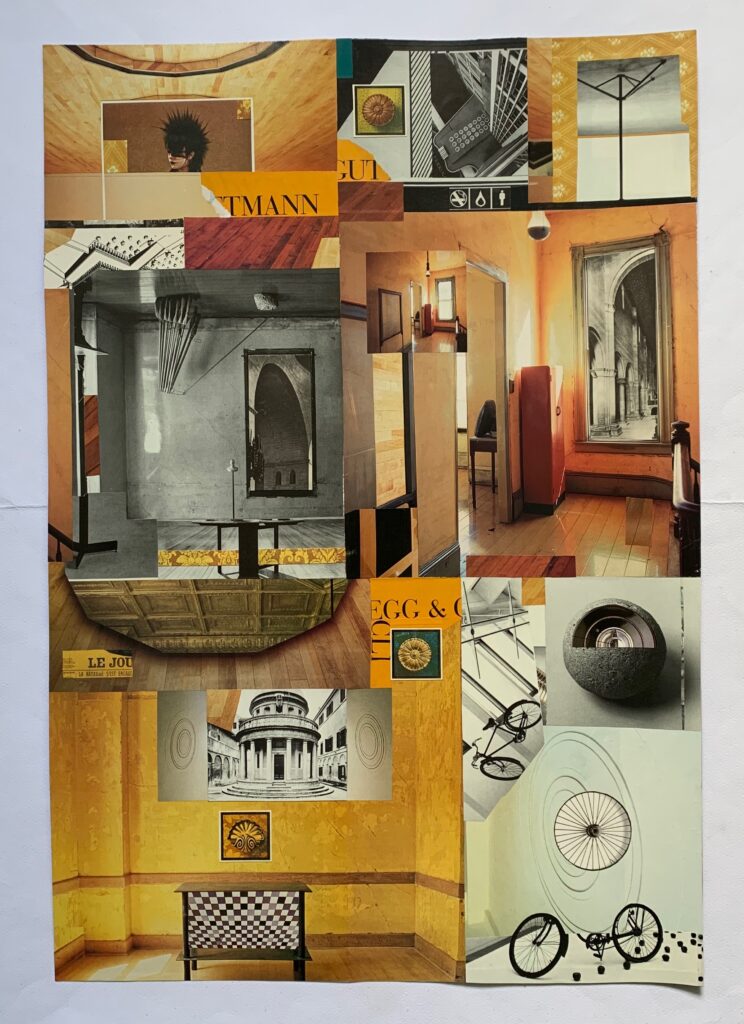
You mention being raised on Rauschenbergs work. How has his style influenced your own creative process and aesthetic?
His Combines and Assemblages of found objects were the big killer, a real arrow to the brain. He taught me never to be afraid to blur beyond the boundaries and distinctions of mediums, to never stop exploring the investigations into finding your true self with pure expression and intellect. I recall reading how he would walk around the block and use only what he found on that brief excursion, a challenge of limitation, which I still use today. Note to self “I will only use 5 objects or images, let’s see what intriguing story or
concept can be developed using just this”. My first solo show wayback in 1999 was under the influence of Rauschenberg. I made assemblage boxes from cupboard draws filled with found parts of machinery, furniture and bits of automobiles after having been in accidents, that I collected from the streets.
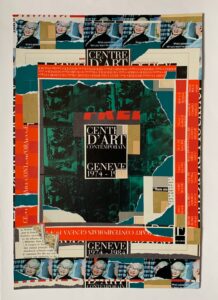 Your latest series was created during a significant change in your living environment. How did moving from a spacious house to an apartment block influence your work?
Your latest series was created during a significant change in your living environment. How did moving from a spacious house to an apartment block influence your work?
At first it made me create space in my art because I didn’t have it physically anymore, so my collages had quite a bit of space and room so I could mentally move around in them. Having breathing space helped with calmness, concentration and focus, and how I was affecting others and how the surrounding environment penetrates your thoughts and emotions. As time has gone on the collages are more busy and frenetic as I don’t want to waste any space now that I’ve adapted to down sizing life. Space is precious, whether its physical or psychological. It’s interesting how having space and not having to worry about it led to the self turning inward to deeper spiritual discoveries and knowledge and how you communicate with that. When you don’t have space you have to learn to adjust and compromise to the frequencies and energies of others and inanimate objects as well. I feel more vulnerable, insecure and defensive housed in like battery chickens (We are Battery Humans). This comes out in the art.
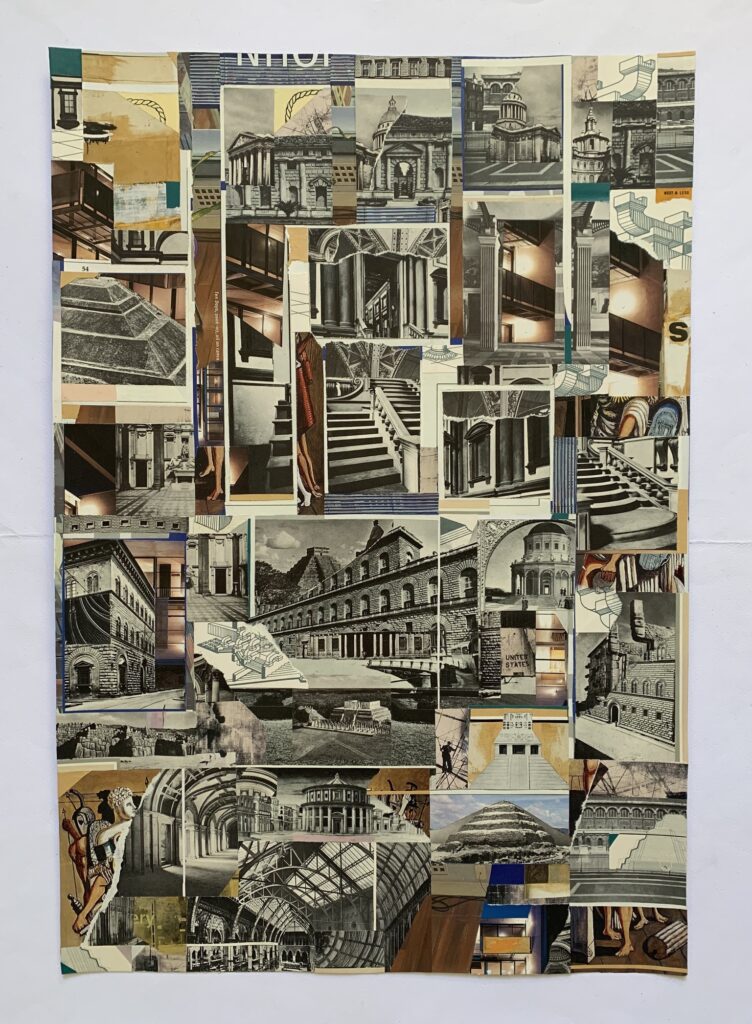
Can you elaborate on the materials you use, such as cardboard, manilla envelopes and second hand book covers, why do you use these specific materials?
Other than the size and storage factors, they are usually easy to carry, transport and manipulate. I like hard cover second hand books that I find or buy cheap and remove all the pages. The cover becomes the back of the artwork, and I collage on the inside so you can close it and its solid and protected. I’ve used folded menu’s also, I like how it gives it a sense of memory, time and place and what I didn’t have to eat or drink.
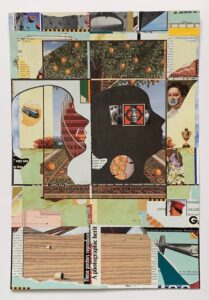 You mentioned working on your collages in various public spaces like cafes, pubs, libraries and even on public transport. How do these different environments affect your creative process and the final pieces?
You mentioned working on your collages in various public spaces like cafes, pubs, libraries and even on public transport. How do these different environments affect your creative process and the final pieces?
When I’m working at home I play records, have the TV on but the volumne on mute and books spread open to wander through them to recreate or mimic the outside world. It’s like I need chaos around me to find the centre of myself. To lose myself is to find myself, the eye of the hurricane is always still and calm and sane compared to whats going on around it. So when in public spaces I’m collaborating with the sounds of the streets with the vibes of my immediate environment and interacting with people in cafes or bars incorporating the mayhem of information. Some of this is absorbed into the art, others used as mere stimulants. It’s also the excitement of taking risks, forcing myself to work quickly, impulsively and haphazardly to see how my thinking process deals and digests this pressure and anxiety. I can tell exactly where and what my mental state was at that particular moment when I look back at the collage.
If you could give one piece of advice to aspiring autodidactic artists, what would it be?
Forget about Society’s traffic, listen to your intuition it will take you Everywhere. Your Intuition will lead you to your Individuation which in turn unearth’s who you really are, allowing the flight of your whole and complete original self.
Instagram
 Could you share more about your journey as an autodidactic artist? What inspired you to start creating art, particularly collages?
Could you share more about your journey as an autodidactic artist? What inspired you to start creating art, particularly collages?
 Your latest series was created during a significant change in your living environment. How did moving from a spacious house to an apartment block influence your work?
Your latest series was created during a significant change in your living environment. How did moving from a spacious house to an apartment block influence your work?
 You mentioned working on your collages in various public spaces like cafes, pubs, libraries and even on public transport. How do these different environments affect your creative process and the final pieces?
You mentioned working on your collages in various public spaces like cafes, pubs, libraries and even on public transport. How do these different environments affect your creative process and the final pieces?
Patrick Sparrow
Great insight on a great Collage Artist.